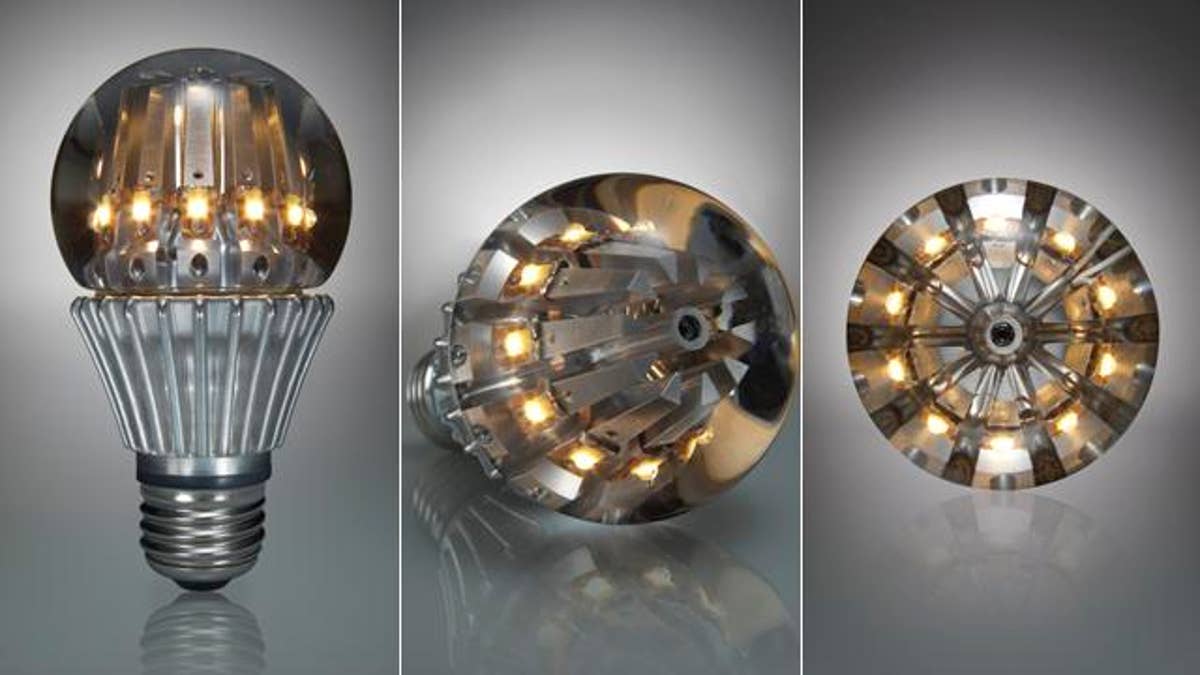
Boasting cooling fins like those found inside some computers, the LED-powered Switch bulb may be the lightbulb of the future. (James Wade, LLC)
If you thought mousetraps were tough, try building a better lightbulb.
Just in time for Earth Day, a team of American inventors have created a bizarre-looking new bulb that turns illumination on its ear, using light-emitting diodes (LEDs) clustered within a conventionally shaped bulb for illumination rather than filaments or fluorescent tubes.
It will never end up in a landfill. It will not poison anybody. It may be the light of the future, hopes Switch Lighting CFO Brett Sharenow.
"You'll be saving energy, you'll be saving the environment, and you'll be saving money," he told FoxNews.com.
Historically, LEDs have faced three challenges. They cast a bluish hue rather than the pleasing yellowish light of incandescent bulbs, they ran hot, and they were too expensive.
The new bulbs emit a more attractive light (around 2,700 Kelvin) and have space-age cooling fins reminiscent of those used to cool computer CPUs. The result is that the heat associated with LEDs, which can shorten their lifespan, is dissipated evenly, allowing them to be used in any standard fixture.
Switch's bulbs, available in 60 and 75 watt equivalent models, last for 20,000 hours -- roughly 10 times longer than standard incandescent bulbs.
Many energy-efficient lights are also too toxic and too expensive, say critics. Switch Lighting says its new light addresses these concerns as well: It's 85 percent more more efficient than household incandescent bulbs, and it's cheap enough that it will pay for itself in less than a year.
Better yet, unlike those twisty compact fluorescent (CFL) bulbs, it contains no mercury and is completely recyclable. It's genesis, Sharenow told FoxNews.com, was remarkable.
"The first LED bulb with this cooling technology was made in a baby food jar," Sharenow said. The inventors built a prototype and put the contraption, LEDs and all, inside the only thing available -- infant food.
"It caused the jar to glow," he said. They knew then they had something special.
The San Jose-based company plans to begin manufacturing in America later this year. The bulbs should cost less than $15 when they come out later this year, Sharenow told FoxNews.com.
Sure, it sounds expensive compared to incandescent bulbs, which cost less than a dollar, but the savings on your power bills could pay for the bulb within the first 12 months of use. And similar LED bulbs already on the market cost $30 or more.
"It has to be business-focused, and not just about the environment," emphasized William McDonough, an architect and designer who has been working with Switch Lighting on the light bulb design to meet so-called "cradle-to-cradle" standards.
That approach means all the components of a device can be reused easily in other devices or put back into the environment to actually benefit the environment. McDonough explains that one could reuse all the glass and rare metals from a gadget and even have a byproduct, such as nitrogen, that could be used as fertilizer for growing food.
The race to more efficient lighting has, well, lit up in recent weeks, sparking competition.
Also this week, Pixi, which makes the LEDs used in television sets, said the company would introduce its own 40-watt equivalent LED bulb later this year. It hopes the cost will be less than $17 a bulb -- much less than the $50 similar bulbs cost just over a year ago.
And Philips, which already sells LED replacement bulbs that cost $30 or more, introduced another cheaper alternative this week. Philips EcoVantage bulbs use halogen lighting elements rather than LEDs but only cost about $1.50 each. On the other hand, they don't offer the same energy savings as LEDs, improving efficiency over incandescent bulbs by only 28 percent.
Even if Switch and other LED makers have managed to create better bulbs, there are still challenges. "No one is making a [satisfactory] 100-watt" equivalent LED bulb Sharenow admitted.
Furthermore, there are still skeptics who would rather fight than switch. South Carolina has introduced a bill to allow companies to continue to make and sell less efficient incandescent bulbs in the state, while congresswoman Michele Bachmann (R-Minn.) and four other representatives have introduced a bill to repeal federal light bulb standards passed in 2007.
Still, with options aplenty on the horizon, the future is beginning to look bright indeed.
Follow John R. Quain on Twitter @jqontech or find more tech coverage at J-Q.com.
